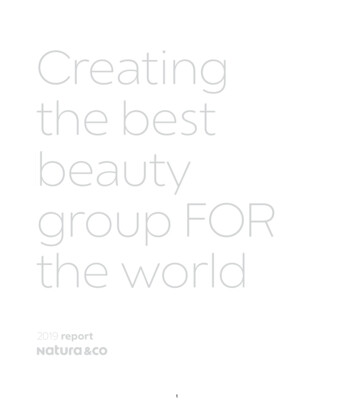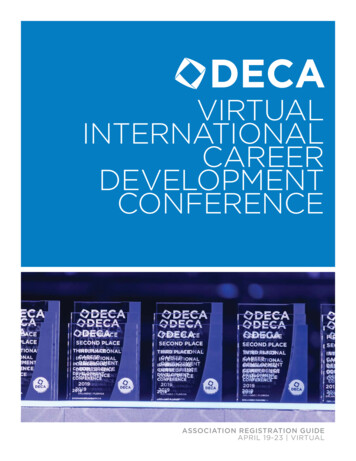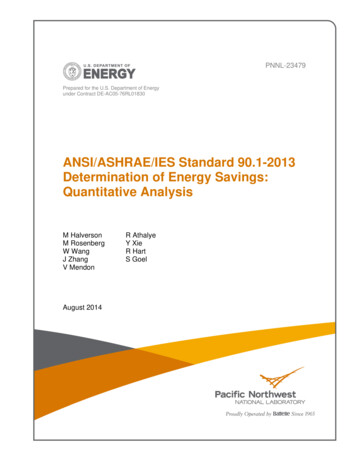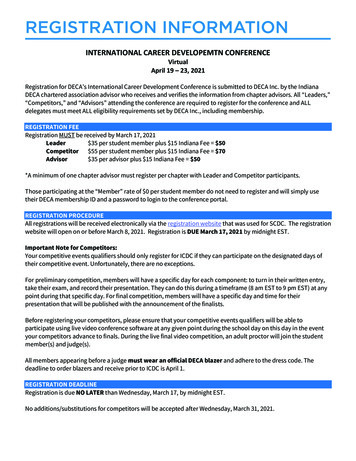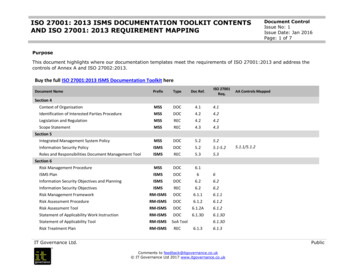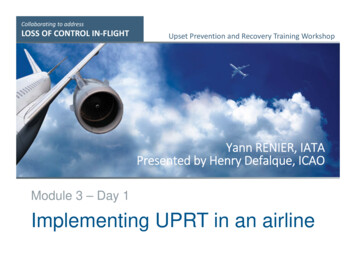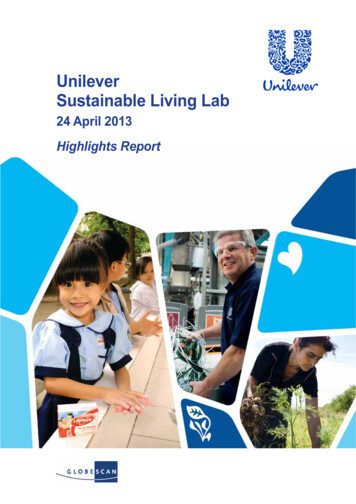
Transcription
UnileverSustainable Living Lab24 April 2013Highlights Report
CONTENTSA MESSAGE FROM PAUL POLMAN 3A MESSAGE FROM GLOBESCAN 3OVERVIEW.5WATER SCARCITY IN THE HOME 6LOWER IMPACT LAUNDRY.8REDUCING PACKAGING WASTE 10HOT WATER FOR SHOWERING 12MAINSTREAMING SUSTAINABLE LIVING 14A RECYCLING REVOLUTION 16THE UNILEVER SUSTAINABLE LIVING LAB 18A Message from Paul Polman,CEO, UnileverA Message from GlobeScanThank you to all those who participated in the Unilever2013 Sustainable Living Lab and generously sharedtheir information, ideas and enthusiasm. I’m particularlygrateful to the team of outside experts, the GlobeScanteam of moderators, and my Unilever colleagues, whotogether helped to make it such an effective and inspiringexperience.The ‘Mainstreaming Sustainable Living’ discussion inwhich I participated gave a real sense of possibility – butalso showed how far there is to go. If we are to succeed,there will be a role both for brands and broader societalcollaboration to play. I am particularly interested in waysin which under-represented voices – young people andwomen among them – can be heard more clearly.As citizens, we all want a better world, where everyone canlive well while living within the world’s natural resources.As companies, therefore, the more our brands canintegrate sustainable living into their brand propositions andinnovation, the better chance we stand of achieving theGlobeScan has been honoured to partner with Unileverover the past two years in developing the Sustainable LivingLab as a way for experts around the world to collaborateonline and help find practical solutions for sustainabilitychallenges in the home.GlobeScan and Unilever firmly believe that innovative waysof large-scale collaboration like the Lab will be essentialin dealing with the challenges we face as societies andfulfilling human promise.Our two decades of tracking public opinion across theworld have shown us how much most of us agree aboutthe sort of future we want to see. And our work engagingwith stakeholders has shown us how ready those withexpertise are to help enlightened organisations like Unileverto achieve progress.We hope that the ideas presented in this Highlights Reportwill serve not only to help shape the work of those whoparticipated, but to inspire others.sustainable consumption needed to improve the world welive in.At Unilever we are fortunate in having the ability to touchThe GlobeScan Teammore than 2 billion consumers’ lives each day through ourbrands. This gives us both the responsibility and opportunityto allow people to live well and live sustainably. Initiativeslike the Sustainable Living Lab are an important way ofhelping us to do that.This report, prepared by GlobeScan, sets out what welearned from this year’s Lab. We look forward to sharingways in which we’ve taken these learnings on board, and towelcoming you again to future Labs.Thank you again.Paul Polman, CEO2Unilever Sustainable Living Lab 24 April 2013Unilever Sustainable Living Lab 24 April 20133
OverviewOn 24 April 2013, 550 experts and practitioners fromThe wealth of ideas generated in the Lab is summarisedbusinesses, NGOs, academia and governments, acrossbelow by topic. First, however, some cross-cutting80 countries, joined the Unilever Sustainable Livingobservations:Lab – an online, global dialogue to co-create solutions tosome of the world’s pressing sustainability challenges.Together, they contributed 1,750 insights and ideas. While Lab discussions were organised into twostreams – Systems and People – the discussions oftenmoved between the two, as participants recognised howThis Highlights Report summarises what we heardpolicy and infrastructure set the boundaries for individualacross the discussions, identifies examples of whatbehaviours, but can also be affected by the adoptionUnilever can do, and suggests what we can all do,of new technologies and service offerings. Hence, thisto accelerate progress on making sustainable livingreport combines comments from both discussions intocommonplace.one set of ideas.This year, the aim of the Lab was to come up This year’s Lab was structured around changingwith creative and innovative insights, ideas andconsumer behaviour, so many of the points covered heresolutions to specific issues where Unilever can playfocus on the demand side of the marketplace (consumera role: minimising environmental impacts at home bychoices and behaviour). The supply side (new productstransforming regulatory and behavioural norms forand services) was also addressed in some comments,laundering, showering, and disposing of waste. Thesebut the balance between the two sides in this report mayareas are among the most vital for delivering on thenot reflect where participating experts would suggest theUnilever Sustainable Living Plan goals and targets.balance needs to be struck.To realise Unilever’s goal to halve the environmentalfootprint of its products across the value chain by 2020,it is clear that cross-industry standards must be elevatedand new social norms and sources of satisfaction forconsumers unlocked.The recognised reality is that both People and Systemsneed to change radically, gravitating towards a commonaim. The sum of the input we received during the Labamounts to a call to create a collaborative movementthat unlocks the business case not just for Unilever,but for peers within and across categories – one thatlays a foundation for systemic change, new businessmodels, and a common vision of the future. We requirechanges in consumer behaviour, and to the systems thatbusinesses and customers operate within, to nurturewhat is already well underway in our socially globalisingand connecting world, particularly in growth markets.Lab participants called upon Unilever to set an example,bring others along, and deliver better livelihoods to thosewhom business serves – citizens and the society inwhich they live.Unilever Sustainable Living Lab 24 April 20135
Water Scarcity in the HomeThe Lab began by addressing water scarcity in the homethrough the question of how Unilever might increaseaccess to water for women in developing countries, whooften face tough choices about their domestic waterconsumption. We also explored what Unilever needs todo in the public policy arena to help consumers adapt towater scarcity.What We HeardWhether addressing water scarcity, greenhouse gasemissions, or waste management systems, the questionof price signals bubbled to the surface. While studiesunder controlled conditions find that cost is a majormotivator of consumer behaviour, participants werewell aware of the tradeoffs that come into play, such asthe ability to meet development and socio-economicequity goals. There was widespread acknowledgement“A tech solution to water scarcityissues: recycled water. Singaporehas done it to great success,and is looking forward to beingcompletely water-independentdespite lack of groundwatersupplies.”“Advertisements can be usedas a tool to reduce excesswater usage shampooadvertisements where peopleshower with a waterfall in thebackground, a full bathtub beingused that is not sustainableadvertising.”that reducing water use in the home is a significantchallenge, and that social norms in this area are hard tochange. Participants felt that a multifaceted response,addressing both people and systems, was needed.Certainly, better public education on the value of wateris vital. However, we know that values education can befruitless and frustrating. Instead we need to look to socialmarketing and sociology to understand how to challengeand shift social norms. For example, participantswondered whether we can redefine cleanliness – or atleast challenge the assumption that large amounts ofwater are necessary to achieve it. Certainly, better publiceducation on the value of water is vital.Participants told us that greater investment in“The role of pricing showingconsumers how it is saving themmoney is still more powerfulto most of them, rather thanshowing them how it’s savingthe environment. Consumers willassume that new sustainabletechnology will cost them eithertime/hassle, quality and perhapssome investment. The privatemonetary gains need to bepublicized.”What Unilever Can DoWhat We All Can Do Adjust advertising to positively portray efficient water use Embrace less intensive technologies such as dry- Launch locally tailored campaigns to tell the waterstory to consumers Advocate for equitable price signals, price structureswashing and demonstrate their efficacy Generate behavioural solutions that help solve waterproblems and enhance personal status simultaneouslyand incentives, backed by real-time information Develop innovative toilet systems Advance dry-washing technology Help make dual-flush toilets the standard Continue to refine product formulation to ensure that Create new business models for laundering thatdetergents are usable at low temperatures and usingincentivise efficient equipment and centralisation torecycled water (see ‘Lower Impact Laundry,’ below)enable onsite water reuse Take to market more water recapture and/or in- Generate markets for water reuseprocess water treatment products Provide consumers with social media tools to learnabout and compare the impacts of different types ofproducts Support social entrepreneurship that eases access toand reuse of water Improve and increase collaboration and creativepartnerships across the value chain Rethink water infrastructure ownership andmanagement – new business models (e.g., moredecentralization, community or collective ownership)technological and business model innovation is needed Advocate for comprehensive policy approaches thatto create market drivers for water reuse, productencourage responsible water use in the industrial andformulation, and packaging. At the same time, we needcommercial sectors, as well as amongst consumers.to challenge social norms around cleanliness to alleviatethe water burden faced primarily by women and childrenin developing and emerging countries.6Unilever Sustainable Living Lab 24 April 2013Unilever Sustainable Living Lab 24 April 20137
Lower-Impact LaundryLab participants were asked to identify radical newsteps that we can take to reduce the greenhouse gasemissions and water impacts of laundry. They alsoconsidered how Unilever can grow its laundry businessin emerging markets without increasing greenhouse gasimpacts across the lifecycle.What We Heard“If you don’t buy your laundrymachine and dishwasher but‘lease’ it, there might be morequality products that are availableto the public, more durable andwater and energy efficient. Thatway I don’t have to afford a supermachine, but just afford to rent it.”The discussion on lower-impact laundry gravitated towardnew business models and approaches to collaboration.There was strong support in the Lab for leasingframeworks for laundry machines in order to ensure wideraccess to the latest and most efficient technologies –which need to operate at lower temperatures than thecurrent standard. Caveats were raised about the need toensure effective recycling of capital equipment, given theanticipated high levels of usage, wear and tear.“A system of recyclingcomponents already existsin some parts of the world. Itcould be more effective if therental companies coordinatedthat, but finding the sweet spotbetween replacing technologyand making full use of producedmachines will be hard.”What Unilever Can DoWhat We All Can Do Further develop products that enable low-energy (and Support leasing business approaches for washinghence low-cost, low-pollution) machine launderingmachines Conduct ethnographic studies to obtain deeper Develop fully-serviced washing centres with optimumunderstanding of the cultural norms surrounding laundryequipment integrated with water recycling facilities that Provide better communications about correct dosagescould also act as community focal points(the Washright initiative was recognised as a positive Unlock and enable the market for efficient (lowcontribution here)temperature and water volume) machinesbased laundries with the most modern and efficient Promote air-drying of laundry where climate Reduce the number of hot water cycles in washingmachines that could be connected to sustainable waterencourages itmachines Increase collaborations with the apparel sector, Increase usage of renewable energy, especially solarfor example, to use nanotechnology to stop clothesand solar water heatingIn the developing world, access to technology might beachieved by promoting a collective model of community-supplies and linked into reuse structures. These laundryfacilities could become focal points for communityinteraction as well. The re-use of handwash water – forexample in cleaning toilets – was also mentioned byseveral as being an important means of maximising theefficient use of water resources in the developing world.Participants also expressed interest in greatercollaboration between manufacturers of washingmachines, apparel and detergents to minimise theimpacts at all stages of the value chain. At the sametime, advocates armed with success stories couldprovide a unified voice directed at public policy.There was also considerable recognition that this isan area where established consumer practices canbe difficult to shift, even when innovative products arebrought to market, due to deeply ingrained cultural“The challenge for Unilever issimilar for Electrolux being awashing machine manufacturer.A lot has been done but we cansurely do more by joining forces.For a washing machine the mostenvironmental impact occursduring the use phase – up to80% of GWP – and this is wherewe have focused by developingmore and more energy and waterefficient machines. The realchallenge is making top-edgeefficient technology availablein emerging markets, andcompetitive!”becoming dirty as quickly Within Europe, liaise closely at EU level with Support eco-efficiency labeling programmes andmandatory standards for white goodspolicymakers to improve product standards for whitegoods Create campaigns to encourage reuse of handwashwater in the homenorms. From the communications perspective,highlighting problematic washing practices with implicitlynegative messages to consumers risks entrenching and‘normalising’ the very behaviours we wish to change.8Unilever Sustainable Living Lab 24 April 2013Unilever Sustainable Living Lab 24 April 20139
Reducing Packaging WasteWhen the conversation turned to reducing packagingwaste, Lab participants were asked to suggest ways wecan alter consumers’ expectation that premium productscome in premium packaging, and what incentives workbest to encourage consumers to recycle.What We Heard“It may be a question of how we enablepeople’s values to connect to the thingwe are expecting/hoping for them to do.There is a huge amount more that needsto be done to communicate the reasonsand importance of recycling Creating theculture of responsibility, creating the ‘norm’and promoting that”Participants commented that reducing packaging wasteand increasing recycling requires mutually reinforcingincentives and disincentives for consumers. Suggestionsincluded penalties for improper disposal of recyclableitems and volume-based disposal fees – even thoughit was acknowledged that measures such as these canbe politically unpalatable. At the same time, the easeand convenience of recycling were seen as in need of“The real sustainability problem iswhen premium products mean premiumpackaging, leading to a higher footprint.We can break this link as premiumproducts don’t automatically mean morepremium packaging – go to a westernfarmers market or check our luxurycosmetics or perfumes at the moment. Inthese and other cases ‘less can be more’”What Unilever Can DoWhat We All Can Do Make sustainability core to design briefs, rather than Influence the design community to become moreperipheral (e.g., through procurement requirements)sustainability-literate (e.g., through professional training Explore how to increase consumer appetite for, andand awards)acceptance of, refillable packaging, e.g., through incentives Reframe the notion of “premium” to be aboutand promotionssustainability and the product, not the packaging Develop “smart packaging” such as wrappers for Promote and support mobile recycling stations inwashing products that dissolve during the washing processareas where infrastructure is lackingcommunications could gradually lead “not recycling” to Develop personalised, long-life packaging to promote Advocate for locally appropriate blends of “carrot andbe viewed in similar terms.product loyaltystick” incentive mechanisms Use clout with packaging designers to drive sustainability Professionalise and support informal recyclingvalues further up the agendasystems to improve their efficiency and the livelihoods ofimprovement.At a more general level, it was suggested that thegradual decline in the social acceptability of litteringprovides a framework here, and that sustainedParticipants felt there is a major role for manufacturerslike Unilever to play in promoting refillable packaging,making products available for bulk purchasing to reducerelative waste volume, devising ‘smart’ packaging, andchallenging consumer norms around the relationshipbetween packaging and a premium positioning.Companies were also called on to help foster a moresustainable mentality among packaging designers,consultancies and manufacturers, whether by ensuringthat sustainability has a high profile on agency briefs,offering prizes, companies setting overall expectationsfor design agencies to be literate in this area, or offeringsustainability ‘boot camps’ for design firms and others.“Most packaging design briefs still containno or minimal reference to sustainabilityaspects, and there is usually little scopeto take a more holistic view, consideringthe product, pack, distribution and POSaspects all together, as these currently are ofcourse developed and designed by differentteams, usually at different times. Therecould be many interesting opportunities toinnovate through taking a broader view and this would be much more challengingand satisfying for design agencies, POSagencies etc. - who would welcomeopportunities to collaborate”informal recyclers“How can we facilitate this as the next stepof the journey? - “Boot camps and Gurucamps””10Unilever Sustainable Living Lab 24 April 2013Unilever Sustainable Living Lab 24 April 201311
Hot Water for ShoweringDuring the first of our afternoon discussions, weexplored what Unilever and its flagship brands can doto support and influence water and energy efficiency athome.What We HeardLab participants identified a number of factors vital tothe transition to sustainable living. Showering habits“So many people don’t realise their wateruse ties directly to energy, their electricitybill. How can people visualise and see theircosts and results?”“Smart metering offers Unilever anopportunity to connect with the consumerabout real time energy usage and putincentives on using less.”are influenced by psychological factors such as therelaxation and refreshment people derive from it,personal habit, and also by the features of the productsthey use. Interventions in this area will need to addressall of these for maximum effect. System change andconsumer behaviour change were deeply intertwined inthis discussion. Any high-level regulatory interventionswere said to need to take into account how they affectpeople’s day-to-day lives.Reframing consumer expectations for an ‘ideal showerexperience’ will be fundamental to any progress,participants said. At the “people” level, we discussedhow a shower with less water and heat, or evenwaterless solutions, can deliver the cleansing, relaxationand enjoyment that people expect. Less-frequenthair washing was identified as a particular area ofopportunity.Several factors that influence behaviour were discussed,such as price signals and real-time information on costs,shower times, and energy and water consumption. Onprice signals specifically, equity and development issueswere well recognised.“A common reason that people have avoidedlow-flow showerheads in the past is that theydon’t like the way they feel. How can wecreate a showering experience that peoplelove that uses very little water? I can imaginevery different systems than we have now.”“Most people who use detergents andshampoo believe that the more shampooyou squeeze to wash your hair or the moredetergent you put in one load, the cleaneryou will be. In terms of shower, this means,you need to consume more water, too. Howabout we invent a shampoo cap that helps theconsumer to squeeze in the right amount ofshampoo?”“Many people don’t really enjoy washingtheir hair and hair washing adds showeringtime. Can we encourage more peopleto use dry shampoo for the ‘in betweenshower’ hair care?”“To help you shorten your showers, youmight try introducing music which youknow ends around the time that you wantyour shower to end, so you see it coming.And, if you have 3 main phases in yourshower (soap, shampoo, and warmth/relax),you might start “cue-ing” each of thosebehaviours at a given time within the music.”12Unilever Sustainable Living Lab 24 April 2013What Unilever Can DoWhat We All Can Do Develop package formats that dispense correct Change showering norms – reduce average showerdosages to reduce overuse and reduce water and energytimes by 20% and water temperature by 10% - by givingconsumption (e.g., Small and Mighty cap size)people new ways to evaluate quality and enjoyment from Support technology and services that provide time, costtheir showersand energy feedback directly to individuals while retaining Make dry-washing or between-shower care productsthe pleasure of showering (e.g., musical shower timers,mainstreamwater metering) Harness peer pressure and competitive spirit by Further research and development on dry-washing (forfacilitating the sharing of information on individuals’bathing and other water-intensive applications like hair-showering durations and water and energy costswashing) Develop high-suds, fast-rinse products and rapidfragrance ones to deliver luxury and utility with less water Increase the use of shower fixtures that use presettemperature regulators and less water flow Advocate for the revision of building codes to include Deploy messaging on the benefits of less frequent hairstricter water and energy efficiency criteria, and forwashing to hair health, etc.efficiency standards for products that heat and deliver Discover and popularise the emotional benefits of lowerimpact showering Create a global event like “Don’t Wash Your Hair Day” towater Support grey water recapture from showers andelsewhere for re-use (e.g., toilet flushing)socialise benefits Work with institutions such as universities and hotels todemonstrate the viability of new water reducing technologyand products to consumers Publish information on best-in-class shower and waterheating appliancesUnilever Sustainable Living Lab 24 April 201313
Mainstreaming SustainableLivingThe discussion explored how we can make sustainableliving desirable and how to create movements for change.We also sought input into what Unilever’s position should beon pricing externalities like carbon and water.Several themes and ideas emerged on creatingconsumer movements. There was agreement thatmovements generally do not start spontaneously –they need to be created or at least catalysed. To doso, coalitions are crucial: multinationals can providebrand power; NGOs, glue and authenticity; academia,credibility; media can embed norms via movies, soapsand cartoons; and social media provides the community.Mass collaborations have a clear role to play, butconsumers (or citizens) need to feel involved in order toWhat We HeardLab participants felt that we have yet to create sufficientmomentum for a transition to sustainable living. To doso, social marketing strategies should not focus purelyon the rationale behind sustainability, but should invokewhat consumers want, explain how they achieve it, andbe aligned with local cultural dynamics. The right balanceof intrinsic factors (e.g., values, aspirations) and extrinsicones (e.g., pricing, new social norms, products andservices) must be found to best motivate each change.People’s beliefs and behaviours will be most affected byexamples and narratives that they can relate to. Participantsfrequently referred to the importance of popular culture indefining mainstream ways of thinking and acting. Whileadvertising can play an important role, more-involved“storytelling” as found in television soap operas was seenas ideal for sustainable “behavioural” as well as “product”placement. Participants also recognised the leadership ofwomen in historic social movements and that women arethe strongest drivers of sustainable living habits.We explored the most effective ways to value negativeexternalities such as water use and carbon emissions.While carbon taxes and emissions trading schemeseach have their advantages, they are not universallyapplicable. What works in one jurisdiction may not workin another – a country with many close geographicalneighbours that implements a carbon tax may see itsbusinesses moving across borders.Trade-off dynamics are complex, and need to be betterunderstood case by case. Another key question is whatsystems best incentivise the innovations that reducethese externalities: turning revenues from a carbon taxinto a prize fund for low-carbon solutions could be anattractive option for all stakeholders.14Unilever Sustainable Living Lab 24 April 2013feel empowered and in control – after all, citizens “own”society. Female leadership is important, to drive a senseof higher purpose, maintain a long-term focus and makepartnerships effective. And engaging youth should bea priority, through movements that appeal to hearts,alongside education programmes that challenge heads.“Desire Rule 1: your audience already hasdesires. Discover how sustainability canfulfil them.”“Today we have access to probably amillion times more connection/collaborationcapability than when man raced to themoon [ ] we are not framing challengeson planet earth in ways that connect thismassive collaboration opportunity.”“Soaps have been proven in differentmarkets to change behaviour. In Mexicoon contraception, in Hollywood on AIDseducation and acceptance of gays Productplacement is normal in the industry. Now weneed to think about “norms” placement insoap [operas].”What Unilever Can DoWhat We All Can Do Collaborate with other leadership companies and “culture In marketing strategy, define the behavioural goalsmakers” to define the desired outcome and establish newwe most seek, and understand how best to make themcultural normsdesirable; target people at key moments (new home, Work with mass media to “place” visions, values andbehaviours in popular culture Edit the choices available to consumers so that theybecome “accidental altruists” Apply branding and marketing sophistication to createconsumer movements and tribes Support carbon pricing but ensure that revenues arededicated to addressing its impactsnew baby) when new patterns will be firming anyway Align sustainability to existing desires, not the otherway around Articulate a better defined, more positive, and widelyunderstood vision of the outcome Let women lead a re-definition of “living well”, anda new “prosumers” movement of citizen-consumersfocused on new ways of achieving “the world we want” Create coalitions of consumers, and involve NGOs toensure authenticity of brand messages Advocate for mechanisms to advance the paybacktimes for eco-efficiency investments“It is often said that carbon is global, and wateris local. To me, this means that we will likelyneed a combination of price-based and nonprice-based mechanisms, blended to meetthe needs of the stakeholders in the region ofinterest.”“Working with youths now to educate andempower the next generation of collaborativeleaders seems like a sound investment.”Unilever Sustainable Living Lab 24 April 201315
A Recycling RevolutionThe final session of the lab investigated ways toincrease recycling among consumers and how Unilevercan best contribute to improving recycling infrastructurein developing markets.What We HeardLab participants stressed the importance ofinfrastructure, regulatory systems and markets whenit comes to recycling. The patchwork nature of wastemanagement infrastructure – among and even withincountries – makes consistent and effective practicechallenging for global companies and for consumers.Education, understanding and social normalisation wereseen as key. There are startling disparities betweencountries in the amount of consumer waste that isrecycled, with many countries seen as lagging becauseof a lack of social pressure, as well as infrastructure.In addition, people need better information andreassurance about what happens to the waste thatthey recycle, suggesting the need for greater trust andcredibility of recycling programmes.Participants discussed how products and packagingcan be optimised for minimum waste across theirlifecycles, and how the waste
6 Unilever Sustainable Living Lab 24 April 2013 Unilever Sustainable Living Lab 24 April 2013 7 What Unilever Can Do Adjust advertising to positively portray efficient water use Launch locally tailored campaigns to tell the water story to consumers
